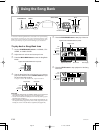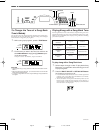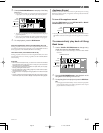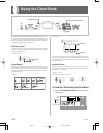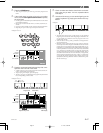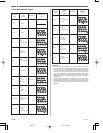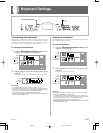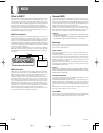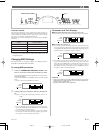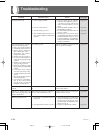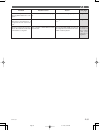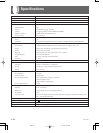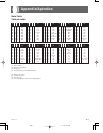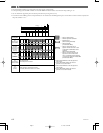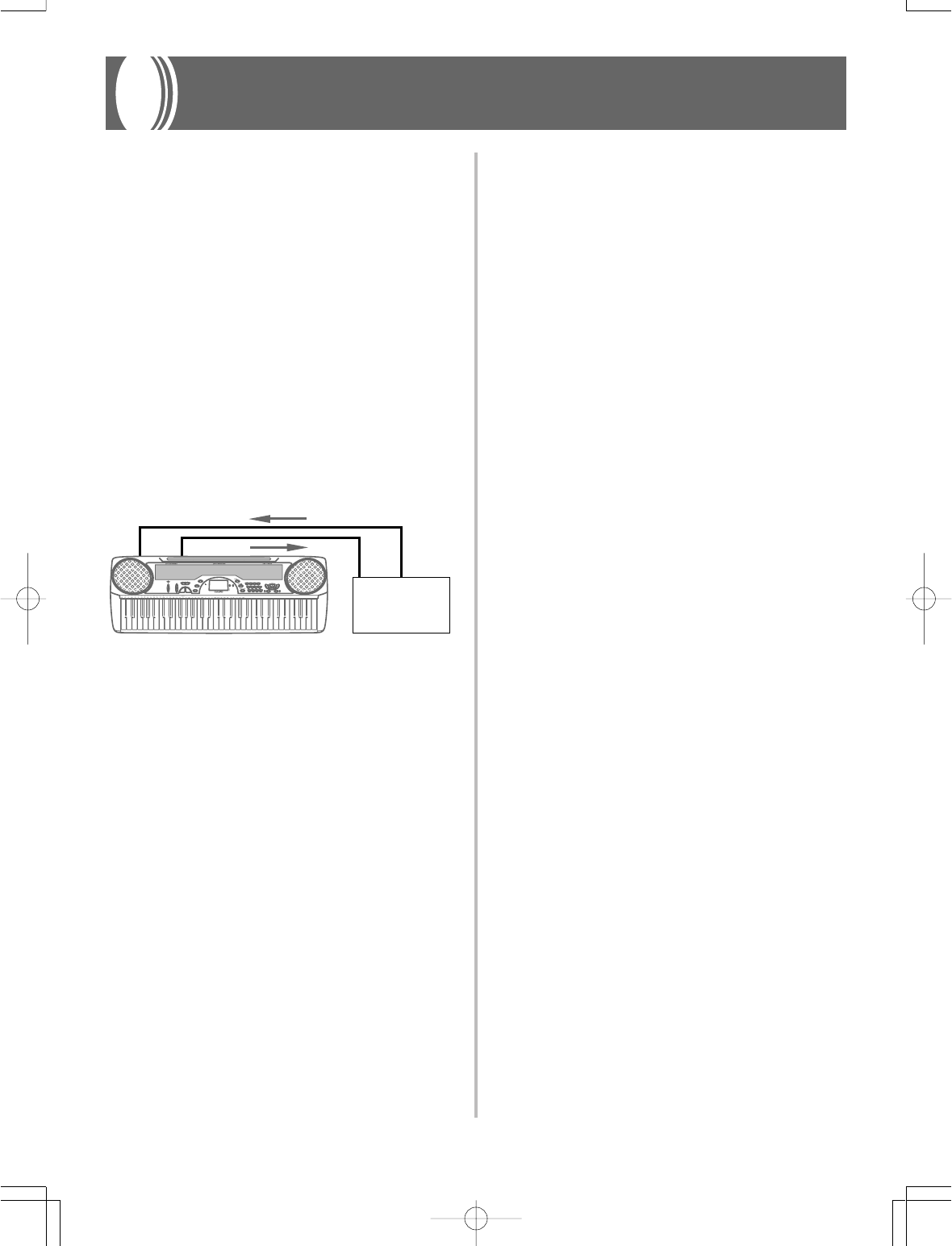
E-30
MIDI
What is MIDI?
The letters MIDI stand for Musical Instrument Digital Interface, which
is the name of a worldwide standard for digital signals and connec-
tors that makes it possible to exchange musical data between musi-
cal instruments and computers (machines) produced by different
manufacturers. MIDI compatible equipment can exchange keyboard
key press, key release, tone change, and other data as messages.
Though you do not need any special knowledge about MIDI to use
this keyboard as a stand-alone unit, MIDI operations require a bit of
specialized knowledge. This section provides you with an overview
of MIDI that will help to get you going.
MIDI Connections
MIDI messages are send out through the MIDI OUT terminal of one
machine to the MIDI IN terminal of another machine over a MIDI
cable. To send a message from this keyboard to another machine, for
example, you must use a MIDI cable to connect the MIDI OUT termi-
nal of this keyboard to the MIDI IN terminal of the other machine. To
send MIDI messages back to this keyboard, you need to use a MIDI
cable to connect the other machine’s MIDI OUT terminal to the MIDI
IN terminal of this keyboard.
To use a computer or other MIDI device to record and playback the
MIDI data produced by this keyboard, you must connect the MIDI
IN and MIDI OUT terminals of both machines in order send and re-
ceive data.
MIDI Channels
MIDI allows you to send the data for multiple parts at the same time,
with each part being sent over a separate MIDI channel. There are 16
MIDI channels, numbered 1 through 16, and MIDI channel data is
always included whenever you exchange data (key press etc.)
Both the sending machine and the receiving machine must be set to
the same channel for the receiving unit to correctly receive and play
data. If the receiving machine is set to Channel 2, for example, it re-
ceives only MIDI Channel 2 data, and all other channels are ignored.
With this keyboard, messages received over MIDI Channels 1, 2, 3, 4,
and 10 can be used for multi-timbre play of up to five different in-
strument parts. The tone and volume settings for these five channels
must be controlled by messages sent from an external device.
When sending operation of this keyboard to an external device, Chan-
nel 1 should be selected as the MIDI send channel.
General MIDI
General MIDI standardizes MIDI data for all sound source types, re-
gardless of manufacturer. General MIDI specifies such factors as tone
numbering, drum sounds, and available MIDI channels for all sound
sources. This standard makes it possible for all MIDI equipment to
reproduce the same nuances when playing General MIDI data, re-
gardless of the manufacturer of the sound source.
Though the sound source of this keyboard is not General MIDI com-
patible, you can still connect the keyboard to a computer or other
MIDI equipment to playback General MIDI data that is widely avail-
able in stores, over computer networks, and from other sources.
❚
NOTES
❚
• General MIDI data made up of a large number of parts may not play
correctly on this keyboard.
• You will have most success playing back General MIDI data that has
few parts and is made up of data on channels 1, 2, 3, 4, and 10.
Messages
There is a wide variety of messages defined under the MIDI stan-
dard, and this section details the particular messages that can be sent
and received by this keyboard.
NOTE ON/OFF
This message sends data when a key is pressed (NOTE ON) or re-
leased (NOTE OFF).
A NOTE ON/OFF message include a note number (to indicate note
whose key is being pressed or released) and velocity (keyboard pres-
sure as a value from 1 to 127). NOTE ON velocity is always used to
determine the relative volume of the note. This keyboard does not
receive NOTE OFF velocity data.
Whenever you press or release a key on this keyboard, the correspond-
ing NOTE ON or NOTE OFF message is sent by constant velocity
from the MIDI OUT terminal.
❚
NOTE
❚
The pitch of a note depends on the tone that is being used, as shown in
the Note Table on page A-1. Whenever this keyboard receives a note num-
ber that is outside its range for that tone, the same tone in the nearest
available octave is substituted.
PROGRAM CHANGE
This is the tone selection message. PROGRAM CHANGE can con-
tain tone data within the range of 0 to 127.
A PROGRAM CHANGE message (0 to 99) is sent out through this
keyboard’s MIDI OUT terminal whenever you manually change its
tone number. Receipt of a PROGRAM CHANGE message from an
external machine changes the tone setting of this keyboard (page E-
31).
This keyboard can send tone data within the range of 00 to 99 and
receive tone data within the range of 0 to 127.
PITCH BEND
This message carries pitch bend information for smoothly sliding the
pitch upwards or downwards during keyboard play. This keyboard
does not send pitch bend data, but is can receive such data.
MIDI IN MIDI OUT
MIDI IN MIDI OUT
START/
STOP
ACCOMP
VOLUME
TEMPO
MAIN VOLUMEPOWER / MODE
FINGERED
100 SONG BANK KEYBOARD
MUSICAL INFOMATION SYSTEM
SYNCHRO /
FILL-IN
CASIO CHORD
NORMAL
ON
OFF
SONG BANK CONTROLLER
TRANSPOSE /
TUNE
CHORD
BOOK
M
LEFT
ON/OFF
REW FF
STOP
SONG BANK CONTROLLER
RIGHT
ON/OFF
PLAY/
PAUSE
m7
7 89
4
56
1023
M7 dim aug
sus4CLEAR -5 add9
MUSICAL INFORMATION SYSTEM
TONE
RHYTHM
SONG BANK
STATUS
TEMPO
MAIN VOLUME
FINGERING/PART
LEFT/
ACCOMP
RIGHT/
MELODY
LR
:1 OCTAVE UP
:PEDAL(SUSTAIN)
622A-E-032A
MIDI sequencer
01.7.26, 10:41 AMPage 30



